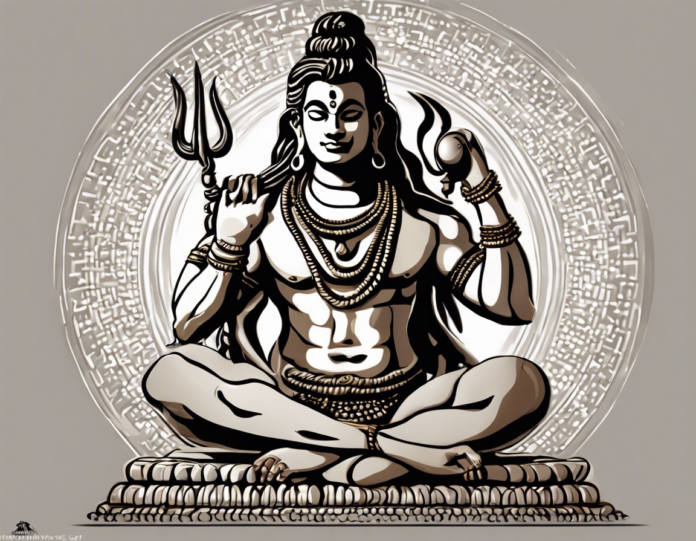Introduction:
In Hindu mythology, Lord Shiva is one of the most revered deities. Known as the god of destruction and transformation, Lord Shiva is also associated with creation and preservation. One of the fascinating aspects of Lord Shiva’s worship is the plethora of names and epithets associated with him. From A to Z, each name carries a unique significance and symbolism, reflecting different attributes and qualities of this divine being. Let’s explore the diverse names of Lord Shiva and their meanings.
A – Adi Yogi:
Adi Yogi refers to Lord Shiva as the “First Yogi” or the primal yogi. This name emphasizes Shiva’s role as the original source of yoga and meditation practices. He is believed to have transmitted the knowledge of yoga to the ancient sages.
B – Bholenath:
Bholenath translates to “the Innocent One.” Despite his fierce appearance and role as the destroyer, Lord Shiva is known for his simplicity, compassion, and innocence.
C – Chandrashekara:
Chandrashekara means “the one who wears the moon as his crest.” This name symbolizes Shiva’s serene and calm nature, as the moon is associated with tranquility.
D – Dakshinamurthy:
Dakshinamurthy signifies Shiva as the ultimate guru or teacher. He imparts knowledge, wisdom, and spiritual guidance to his disciples in the form of a silent teacher, sitting under a banyan tree.
E – Ekalinga:
Ekalinga represents Shiva as the “One Linga.” The term underscores the unity and oneness of the divine, with the linga being a symbol of cosmic energy and creation.
F – Fakiranath:
Fakiranath portrays Shiva as the king of ascetics and wandering mystics. He is often depicted as a renunciant who has transcended worldly desires and attachments.
G – Gaurikant:
Gaurikant refers to Shiva as the husband of Goddess Gauri or Parvati. The name highlights the divine union of the masculine and feminine energies in the form of Shiva and Parvati.
H – Hara:
Hara signifies Shiva as the one who destroys or dissolves the universe at the end of each cycle of creation. It represents the transformative aspect of Shiva’s role as the destroyer of ignorance and ego.
I – Ishwara:
Ishwara denotes Shiva as the supreme lord and ruler of the universe. He is the cosmic consciousness that governs all aspects of creation, preservation, and destruction.
J – Jatadhar:
Jatadhar characterizes Shiva as the one with matted locks of hair. His unkempt hair symbolizes his disregard for earthly vanity and his free-spirited nature.
K – Kailasapati:
Kailasapati signifies Shiva as the lord of Mount Kailash, his abode in the Himalayas. Mount Kailash is considered a sacred place and the center of the universe in Hindu cosmology.
L – Lingaraja:
Lingaraja means “the king of Lingas.” Shiva is often worshipped in the form of a Linga, a phallic symbol representing the divine creative energy of the universe.
M – Mahadeva:
Mahadeva translates to “the Great God.” This name emphasizes Shiva’s supreme and divine nature as the ultimate reality beyond all dualities.
N – Nataraja:
Nataraja depicts Shiva as the cosmic dancer performing the divine dance of creation, preservation, and destruction. His dance symbolizes the rhythm of the universe.
O – Omkara:
Omkara represents Shiva as the embodiment of the sacred sound OM, the primal vibration of the universe. OM is considered the sound of creation and the essence of all mantras.
P – Pashupati:
Pashupati means “the lord of all beings.” Shiva is revered as the protector and guardian of all creatures, embodying compassion and mercy towards all living beings.
Q – Qualities of Shiva:
While there might not be a direct name starting with ‘Q,’ it is essential to highlight some key qualities associated with Lord Shiva. Shiva is known for his qualities of compassion, detachment, austerity, and wisdom, inspiring his devotees to cultivate these virtues.
R – Rudra:
Rudra signifies Shiva as the fierce and wrathful aspect of the divine. He is the storm god who can bring destruction and transformation, symbolizing the power of nature.
S – Shankara:
Shankara translates to “the auspicious one.” Shiva is considered the source of blessings, auspiciousness, and well-being. This name highlights his benevolent and compassionate nature.
T – Trilochana:
Trilochana means “the three-eyed one.” Shiva is often depicted with a third eye on his forehead, symbolizing his ability to see beyond the physical realm into the realms of spirit and higher consciousness.
U – Umapati:
Umapati refers to Shiva as the husband of Goddess Uma, another name for Parvati. This name underscores the divine relationship between Shiva and Parvati, symbolizing the union of Shakti (divine feminine) and Shiva (divine masculine).
V – Vaidyanath:
Vaidyanath signifies Shiva as the lord of physicians and healing. He is believed to possess the power to cure all physical and spiritual ailments, offering divine healing energies to his devotees.
W – Who is Shiva?
Shiva is one of the principal deities in Hinduism, alongside Brahma the creator and Vishnu the preserver. He is worshipped as the supreme being who embodies the dualities of creation and destruction, symbolizing the cyclical nature of existence.
X – Xenial Lord:
Though ‘X’ is a challenging letter to find an exact match, it is fitting to describe Shiva as a xenial lord who welcomes devotees from all walks of life with open arms. His inclusive nature transcends boundaries of caste, creed, and culture.
Y – Yogeshwara:
Yogeshwara translates to “the lord of yoga.” Shiva is considered the supreme yogi who has mastered the practice of yoga, both in its physical form and as a path to spiritual enlightenment.
Z – Zenith of Enlightenment:
Shiva represents the zenith of enlightenment and spiritual realization. By meditating upon Shiva and embodying his qualities, devotees aim to reach the highest state of consciousness and liberation from the cycle of birth and death.
Frequently Asked Questions (FAQs) about Lord Shiva:
Q1: What is the significance of the trident (Trishul) that Lord Shiva carries?
A: The trident symbolizes Shiva’s threefold power of creation, preservation, and destruction. It also represents the three gunas (qualities) of nature – Sattva (purity), Rajas (passion), and Tamas (ignorance).
Q2: Why is Lord Shiva often depicted covered in ash (Bhasma)?
A: The ash represents the transient nature of life and the ultimate reality of death. It symbolizes the impermanence of the physical body and the eternal nature of the soul.
Q3: What is the significance of the serpent (Naga) around Shiva’s neck?
A: The serpent symbolizes Shiva’s mastery over fear and the cycle of life, death, and rebirth. It also represents Kundalini energy, the divine force within all beings waiting to be awakened.
Q4: How does Lord Shiva’s third eye represent his powers?
A: Shiva’s third eye symbolizes his ability to see beyond the illusions of the physical world and into the realm of truth and higher consciousness. It represents his power to destroy ignorance and reveal inner wisdom.
Q5: What are some of the major festivals dedicated to Lord Shiva?
A: Some of the popular festivals dedicated to Lord Shiva include Maha Shivaratri, Shravan Month (Sawan), Pradosha Vrata, and Shiva Ratri.
Q6: Why does Lord Shiva adorn a crescent moon on his head?
A: The crescent moon on Shiva’s head symbolizes the cyclical nature of time and the changing phases of life. It also represents rejuvenation and the power of immortality.
Q7: What is the significance of Lord Shiva’s blue throat (Nilakantha)?
A: The blue throat of Shiva is attributed to the incident during the churning of the ocean (Samudra Manthan) when he drank the poison (halahala) to save the world from destruction. It symbolizes his selfless sacrifice for the greater good.
Q8: How does Lord Shiva’s role as Nataraja symbolize the cosmic dance of creation and destruction?
A: As Nataraja, Shiva’s dance symbolizes the eternal rhythm of the universe, where creation leads to preservation, which eventually results in destruction and transformation. It highlights the interconnectedness of all aspects of existence.
Q9: What are some of the mantras dedicated to Lord Shiva for meditation and worship?
A: Some of the popular mantras dedicated to Lord Shiva include the Maha Mrityunjaya Mantra, Om Namah Shivaya, Rudra Gayatri Mantra, and Shiva Panchakshara Stotram.
Q10: How can devotees connect with the energy and presence of Lord Shiva in their daily lives?
A: Devotees can connect with Lord Shiva through regular meditation, chanting of mantras, practicing yoga, visiting sacred temples dedicated to Shiva, observing fasts on auspicious days, and embodying the qualities of Shiva such as compassion, humility, and devotion.
In conclusion, Lord Shiva’s names from A to Z offer a glimpse into the multifaceted nature of this divine being and the rich symbolism associated with his worship. Each name embodies a unique aspect of Shiva’s persona, teachings, and cosmic significance, inviting devotees to deepen their understanding and reverence for the lord of transformation and enlightenment.


Recent comments